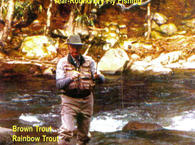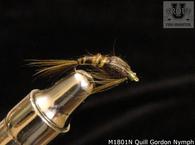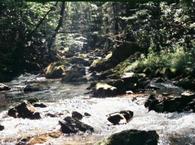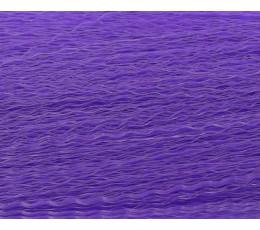Trout fishing in the infertile waters:
The bad news is that you'll have trouble predicting what kinds of food are prevalent in an unfamiliar infertile stream. The good news is you probably won't have to. Further good news is that the flies you can get away with will be larger. Trout in infertile rivers don't have the luxury of being selective, because they don't see enough of any particular insect to get picky about which one they choose. Either trout eat every piece of food that looks remotely edible or they starve. In most fertile rivers the quantity of
aquatic insect larvae available to the trout by midsummer is insignificant, and they depend on
terrestrial insects that fall iinto the water for a great part of their food. Since trout never see many of the same kind of aquatic insects, and the terrestrials they feed on are a stew of all shapes, sizes, and colors, they prefer to eat the largest morsel of food available, providing all else being equal. All you have to do is turn over a few rocks or shake the bushes and decide what is the largest edible insect they are likely to recognize.
On infertile rivers, pass up much of the water, the stuff that doesn't look fishy. Move faster between spots, then concentrate hard on the best looking water. You can also move faster on infertile rivers because the trout don't agonize over fly patterns, so neither should you. Trout in infertile rivers will move farther for a fly, so unerring casts are not as important here, and if your fly lands within a foot of where you think a trout is lying and floats drag-free (or swings properly if you're fishing a wet or streamer), make a few more casts and move on. I don't want to suggest that you get sloppy, but many times trout in unproductive streams move five feet for a dry fly. As we have mentioned before, the cane pole technique can be effective with brook trout in these infertile waters. The only time a trout will move this far on a fertile river is when there are large, meaty flies like salmon flies (a huge, size 4 or 6 stonefly that hatches on western rivers) or grasshoppers on the water.
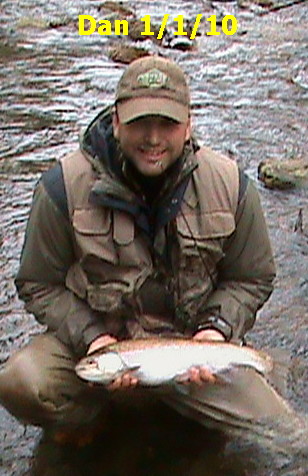
Trout fishing in the fertile waters:
In more fertile rivers you have to pay greater attention to what's on the trouts’s menu. The trout are used to seeing multiple foods at any given time, and although trout are not usually selective to a given species of insect, most of their food falls into specific parameters of size, shape, and color. If you go outside of that realm, you won't draw as many strikes. Here the largest available food item might be rare enough that trout don't recognize it.
If you intend to fish only to rising fish during hatches, geology and a knowledge of stream reading are unimportant. You need only sample the drift to find out what flies will work, and you know where the trout are because you can see them feeding. But when you prospect without the benefit of hatches, you need other clues to help you select flies and find trout. The relative richness of a river, which you can usually determine with a few minutes of observation, is one of the most important clues.
I've found that in richer rivers, smaller flies are more effective in catching trout. I'm not exactly sure why. Perhaps it's because smaller insect life is more abundant, and the trout are more likely to take a fly that's similar to what they're eating, while the trout in an infertile stream grab almost anything that looks edible.
In the Battenkill, for example, most of the nymphs are small, skinny, and brownish olive-dull. If you turn over enough rocks, though, you'll sometimes find a couple of those giant black stoneflies that trout go crazy over in the Rocky Mountains. I have tried size 6 stonefly nymphs in the Battenkill year after year, with never even a touch. Not only do the trout not eat them, I bet if I could look underwater I'd see them bolting for cover when that ugly nymph rolls into the neighborhood.
Trout in rich rivers are evenly distributed, all over the place, because there is enough food to support trout everywhere. Even in shallow sloughs with a mud or sand bottom, spots that look more suitable for minnows or frogs, trout can be found. In fact I've noticed that large brown trout in spring creeks seem to prefer these places over the deeper channels. On the other hand, in infertile rivers trout distribution is spotty. They will not be found in backwaters because it might be an hour's wait for a piece of food to drift by, even at the height of a heavy hatch. So trout in rivers that aren't so rich frequent the logical spots, the places that scream for a well-placed cast with an Adams or Hare's Ear nymph. These logical places are the areas protected from the heaviest flow of water, but close enough to the main current so a sideways tip will allow trout to intercept food. At the edge of seams, at the tail of a pool, in front of and behind rocks, and where the head of the pool spills over a shelf-these are all logical places.
On rich streams, cover all the water. Never assume that a trout won't be right in front of you, and concentrate on covering the water closest to you with repeated casts, changing flies or techniques often if you aren't getting any strikes.
The number and size of trout a stream can support are always limited by something, but almost never by fishing pressure or other predation. Populations of trout are usually limited by the physical features of the stream, and you can make predictions about how many trout a stream holds by an estimation of its richness. Infertile streams have little migration, stunted adults, and many juveniles. Rich trout streams, on the other hand, are space-limited. Trout can get enough food anywhere in the stream, and the total number of trout is limited by the number of available places to hold and feed without wasting an inordinate amount of energy. A rich trout stream with a bottom covered with rubble of different-sized rocks offers lots of nooks and crannies to break the force of the current, and it can hold many more trout than a stream of equal richness with a sand or gravel bottom.
A spring creek with many weedbeds offers protection from the current and places for the trout to hide when danger threatens, and it can hold more trout than an equally rich stream that has been widened, shallowed, and trampled by cattle. Exerpts from
The Orvis Guide to Prospecting for Trout. by
Tom Rosenbauer.
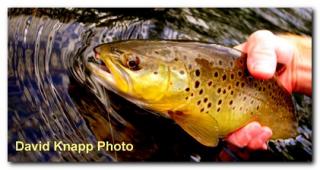
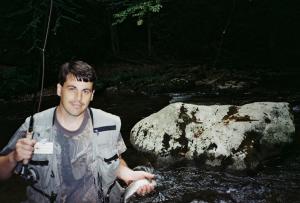
 Trout fishing in the fertile waters:
Trout fishing in the fertile waters:

